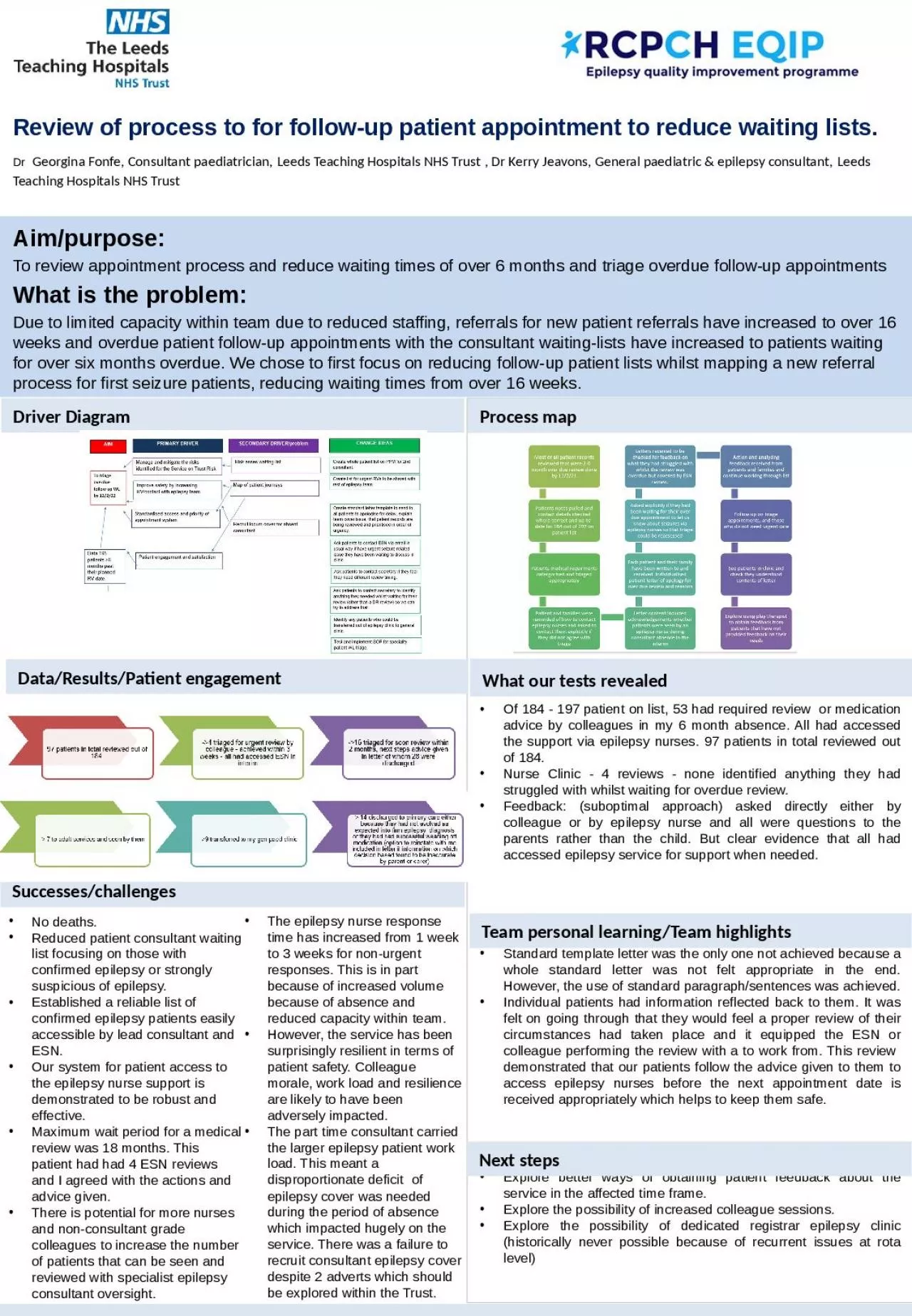

Dr Georgina Fonfe Consultant paediatrician Leeds Teaching Hospitals NHS Trust Dr Kerry Jeavons General paediatric amp epilepsy consultant Leeds Teaching Hospitals NHS Trust ID: 1032205
Download Presentation The PPT/PDF document "Review of process to for follow-up patie..." is the property of its rightful owner. Permission is granted to download and print the materials on this web site for personal, non-commercial use only, and to display it on your personal computer provided you do not modify the materials and that you retain all copyright notices contained in the materials. By downloading content from our website, you accept the terms of this agreement.
1. Review of process to for follow-up patient appointment to reduce waiting lists. Dr Georgina Fonfe, Consultant paediatrician, Leeds Teaching Hospitals NHS Trust , Dr Kerry Jeavons, General paediatric & epilepsy consultant, Leeds Teaching Hospitals NHS Trust Of 184 - 197 patient on list, 53 had required review or medication advice by colleagues in my 6 month absence. All had accessed the support via epilepsy nurses. 97 patients in total reviewed out of 184.Nurse Clinic - 4 reviews - none identified anything they had struggled with whilst waiting for overdue review. Feedback: (suboptimal approach) asked directly either by colleague or by epilepsy nurse and all were questions to the parents rather than the child. But clear evidence that all had accessed epilepsy service for support when needed.Standard template letter was the only one not achieved because a whole standard letter was not felt appropriate in the end. However, the use of standard paragraph/sentences was achieved. Individual patients had information reflected back to them. It was felt on going through that they would feel a proper review of their circumstances had taken place and it equipped the ESN or colleague performing the review with a to work from. This review demonstrated that our patients follow the advice given to them to access epilepsy nurses before the next appointment date is received appropriately which helps to keep them safe.Complete the review of the rest of the epilepsy Waiting list.Explore better ways of obtaining patient feedback about the service in the affected time frame.Explore the possibility of increased colleague sessions.Explore the possibility of dedicated registrar epilepsy clinic (historically never possible because of recurrent issues at rota level)Aim/purpose: To review appointment process and reduce waiting times of over 6 months and triage overdue follow-up appointmentsWhat is the problem:Due to limited capacity within team due to reduced staffing, referrals for new patient referrals have increased to over 16 weeks and overdue patient follow-up appointments with the consultant waiting-lists have increased to patients waiting for over six months overdue. We chose to first focus on reducing follow-up patient lists whilst mapping a new referral process for first seizure patients, reducing waiting times from over 16 weeks.Next stepsProcess map Data/Results/Patient engagementTeam personal learning/Team highlightsWhat our tests revealedSuccesses/challengesDriver DiagramNo deaths.Reduced patient consultant waiting list focusing on those with confirmed epilepsy or strongly suspicious of epilepsy.Established a reliable list of confirmed epilepsy patients easily accessible by lead consultant and ESN.Our system for patient access to the epilepsy nurse support is demonstrated to be robust and effective. Maximum wait period for a medical review was 18 months. This patient had had 4 ESN reviews and I agreed with the actions and advice given.There is potential for more nurses and non-consultant grade colleagues to increase the number of patients that can be seen and reviewed with specialist epilepsy consultant oversight.The epilepsy nurse response time has increased from 1 week to 3 weeks for non-urgent responses. This is in part because of increased volume because of absence and reduced capacity within team. However, the service has been surprisingly resilient in terms of patient safety. Colleague morale, work load and resilience are likely to have been adversely impacted.The part time consultant carried the larger epilepsy patient work load. This meant a disproportionate deficit of epilepsy cover was needed during the period of absence which impacted hugely on the service. There was a failure to recruit consultant epilepsy cover despite 2 adverts which should be explored within the Trust.